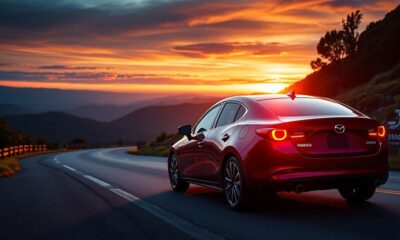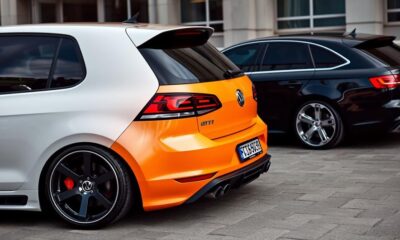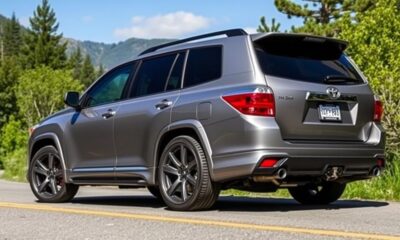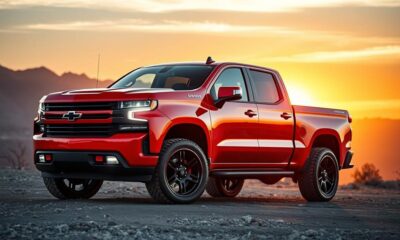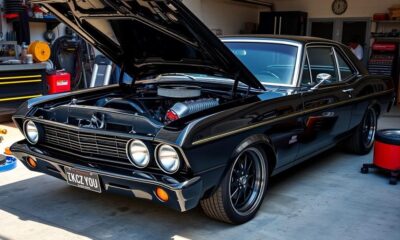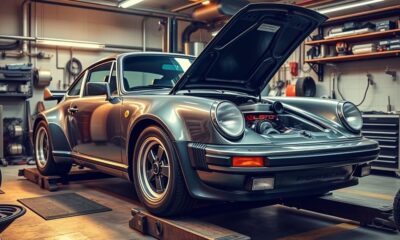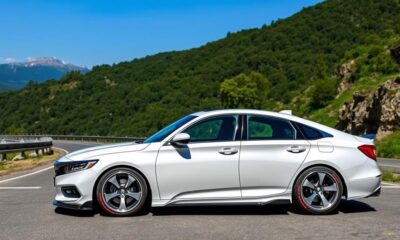Hyundai Tuning
Hyundai Accent 2010 Tuning: Bringing Modern Performance to Your Subcompact Car
Fuel your passion for performance as we explore how to transform your 2010 Hyundai Accent into a thrilling ride that will leave you wanting more.
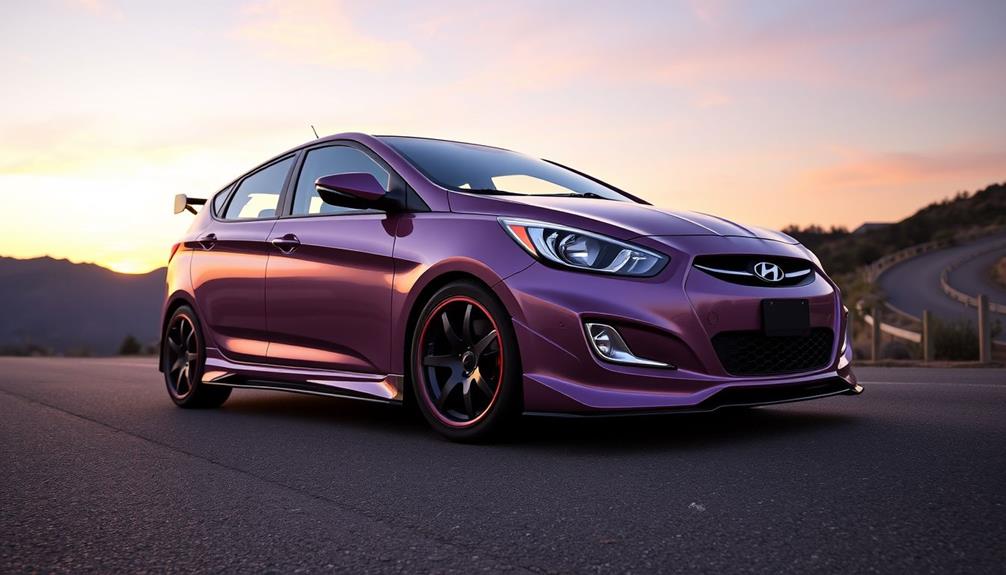
Tuning your 2010 Hyundai Accent can elevate your driving experience, transforming it from a modest subcompact to a spirited performer. You can boost responsiveness and handling by upgrading components like the K&N air filter and a free flow exhaust system. Installing a turbo kit might even give you a remarkable 30-50% horsepower increase. Don't forget about suspension upgrades like KYB shocks or coilovers for better cornering. With proper ECU tuning, you'll maximize airflow and enhance throttle response. There's a vibrant community of enthusiasts ready to share tips and resources to help you make the most of your Accent.
Key Takeaways
- Upgrading to a K&N air filter and free flow exhaust enhances airflow, improves responsiveness, and increases overall performance in your 2010 Hyundai Accent.
- Installing a turbo kit can yield a significant 30-50% boost in horsepower, transforming your Accent's performance capabilities.
- ECU tuning optimizes fuel mapping, achieving gains of 10-20% in horsepower and torque for a more responsive driving experience.
- Suspension upgrades like KYB rear shocks and coilovers improve handling, ride quality, and cornering stability for a sportier driving feel.
- Engaging with the Hyundai Accent community provides valuable DIY resources and support for successful tuning and modification projects.
Overview of the Hyundai Accent
When you think of a reliable subcompact car, the 2010 Hyundai Accent stands out. Powered by a 1.6L I4 Alpha II engine, it delivers 110 horsepower and 106 lb-ft of torque, making it a competitive choice among Hyundai models.
You'll appreciate the impressive fuel economy, achieving up to 36 MPG on the highway, which easily surpasses rivals like the Honda Fit and Nissan Versa.
The Accent's spacious interior, with a total volume of 104.6 cubic feet in the four-door sedan, offers more passenger room than competitors such as the Toyota Corolla and Honda Civic. This added space enhances your overall driving experience, allowing you and your passengers to travel comfortably.
Safety is another highlight, as the Accent features six airbags and boasts a five-star frontal crash safety rating from NHTSA. This means you can drive with peace of mind, knowing that occupant protection is a priority.
Since its introduction in 1994, the Accent has undergone several updates, consistently delivering reliability and affordability, making it an attractive option for first-time buyers and budget-conscious consumers alike.
Benefits of Modifying Your Accent
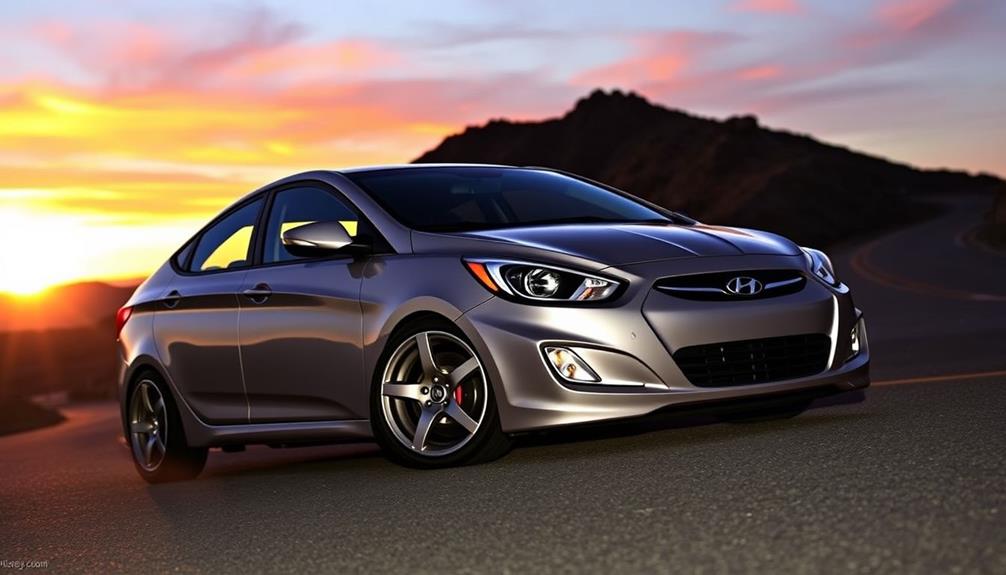
Modifying your 2010 Hyundai Accent can transform your driving experience in exciting ways. By investing in performance modifications, you can achieve significant improvements in responsiveness and handling.
For instance, a K&N drop-in filter enhances engine airflow, allowing your Accent to respond quicker without a drastic horsepower increase. If you want more power, consider installing a turbo kit, which can yield a remarkable 30-50% boost in horsepower, dramatically enhancing your acceleration and overall driving enjoyment.
Improving your car's handling is equally essential. Upgrading to KYB rear shocks can provide a more stable and comfortable ride, making your Accent feel planted on the road.
Additionally, implementing coilovers will lower your car's center of gravity, resulting in better cornering capabilities. Don't forget about the exhaust system; shifting to a free flow exhaust enhances both engine efficiency and sound, giving your car a sportier feel.
Key Performance Upgrades
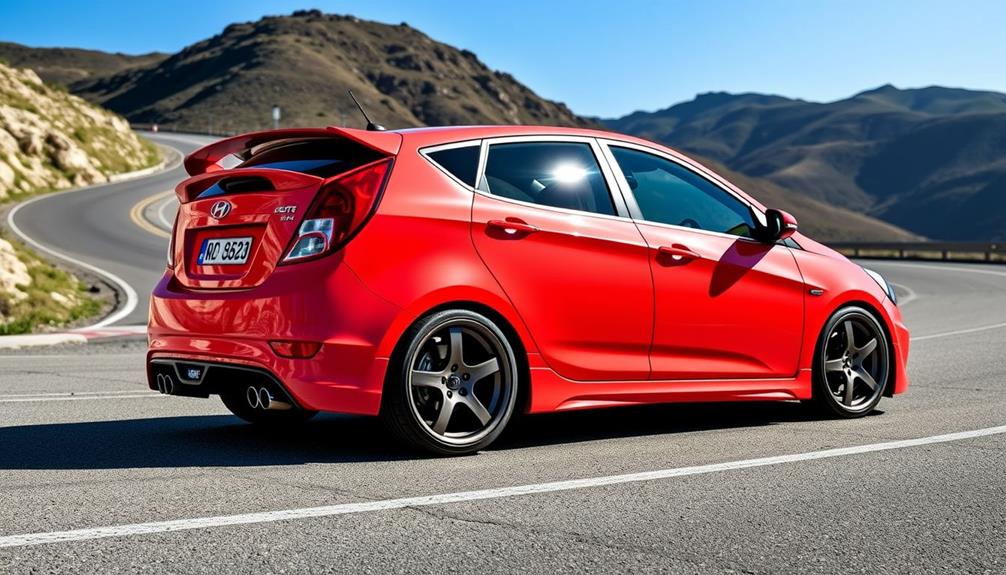
When tuning your Hyundai Accent, focusing on key performance upgrades can make a noticeable difference.
Start with essential engine modifications like a K&N air filter or a free flow exhaust system to boost airflow and power.
Don't forget about suspension enhancements, such as KYB rear shocks, to improve handling and overall driving experience.
Essential Engine Modifications
To access the full potential of your 2010 Hyundai Accent, focusing on essential engine modifications is a smart move. Upgrading your engine's components can lead to significant enhancements in performance and responsiveness.
Here are some key modifications to take into account:
- K&N drop-in air filter: Elevate your engine's responsiveness with improved airflow.
- Injen cold air intake system: Maximize airflow for better performance, especially on 91 octane fuel.
- Free flow exhaust (FFE) with headers: Experience boosted power output and throttle response by reducing exhaust backpressure.
- Turbo kit or engine swap: For substantial horsepower gains, think about these options for a 30-50% increase, though be aware of complexity and costs.
- Proper tuning: Confirm your modifications are fine-tuned on a dyno for ideal results.
These modifications not only enhance your engine's capabilities but also elevate your driving experience.
By investing in these essential upgrades, you'll feel the difference in performance, making every drive more exhilarating.
Don't hold back—give your Accent the power it deserves!
Suspension and Handling Enhancements
Suspension upgrades can transform your 2010 Hyundai Accent into a nimble, agile machine. By enhancing the suspension and handling, you can achieve a more enjoyable driving experience. Here are some key performance upgrades to take into account:
| Upgrade Type | Benefits |
|---|---|
| KYB Rear Shocks | Improved handling and ride quality |
| Kia Rio Coilovers | Adjustable ride height for better aesthetics |
| Front Sway Bar | Reduced body roll for enhanced cornering |
| Performance Brake Upgrades | Increased stopping power and reduced brake fade |
| Strut Tower Braces | Enhanced chassis rigidity for better feedback |
Upgrading to KYB rear shocks will greatly enhance responsiveness during cornering, while coilovers allow you to adjust ride height for both style and performance. A front sway bar minimizes body roll, considerably improving cornering stability. Don't forget about performance brake upgrades; they're essential for maintaining control during spirited driving. Finally, strut tower braces improve chassis rigidity, leading to superior steering feedback and handling precision. With these upgrades, your Accent will feel more like a performance car on the road.
Engine and Exhaust Modifications
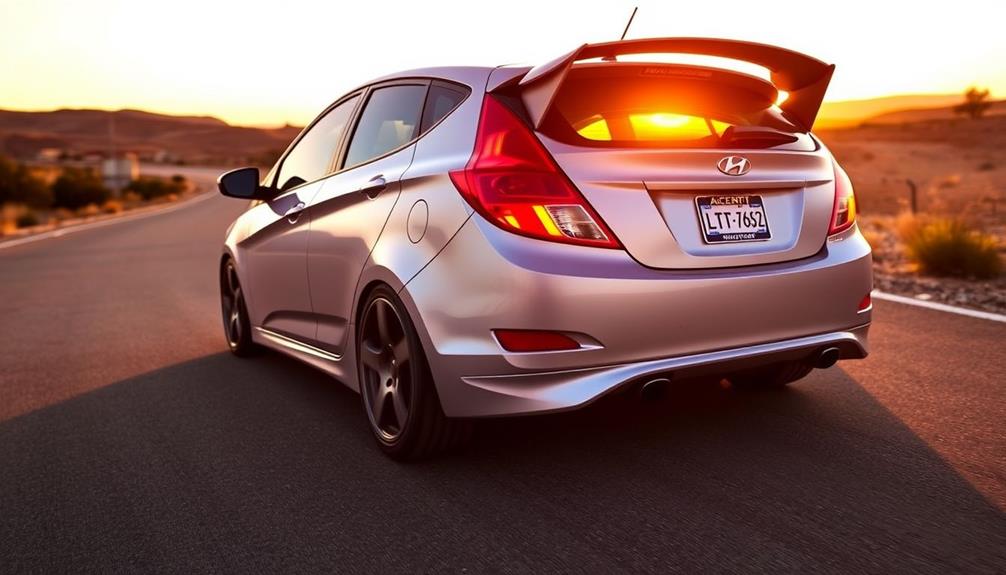
When it comes to boosting your Hyundai Accent's performance, upgrading the air filter and exhaust system can make a noticeable difference.
A K&N drop-in air filter improves airflow, while a free flow exhaust system enhances throttle response and torque.
Pairing these upgrades with ECU tuning options can maximize your engine's potential and take your driving experience to the next level.
Performance Air Filters
Upgrading your Hyundai Accent's performance air filters can greatly enhance engine responsiveness and efficiency. By installing a high-quality K&N drop-in air filter, you'll notice improved airflow, which translates to better throttle response without a significant increase in horsepower.
When paired with other modifications, these performance air filters can boost fuel efficiency by up to 9%, making your daily drive more economical.
Consider the emotional impact of improving your vehicle:
- Feel the thrill of quicker acceleration.
- Experience smoother driveability on every road.
- Enjoy the satisfaction of saving on fuel costs.
- Relish in the longevity of your engine with regular maintenance.
- Embrace the pride of owning a finely-tuned subcompact.
Additionally, open filter cold air intakes can further enhance airflow, although they may reduce low-end torque.
Regularly replacing and maintaining your performance air filters guarantees peak air quality, preventing debris buildup and prolonging engine life.
Exhaust System Upgrades
Enhancing your Hyundai Accent's exhaust system is a natural next step after improving its air intake. Upgrading to a free-flow exhaust system (FFE) with headers can greatly boost your engine's performance. By enhancing exhaust flow, you can expect increased horsepower and torque, making your car more lively on the road.
Properly designed headers improve throttle response and low-end torque, allowing for a more responsive acceleration experience.
Consider installing a cat-back exhaust system as well; it not only offers a deeper, more aggressive exhaust note but also contributes to a slight horsepower increase due to reduced back pressure.
For peak performance, don't overlook header wrapping. This technique helps retain heat within the exhaust system, improving efficiency and lowering under-hood temperatures.
ECU Tuning Options
Accessing the full potential of your 2010 Hyundai Accent often comes down to ECU tuning options that can greatly elevate engine performance.
By optimizing fuel mapping and ignition timing, you can achieve impressive performance gains of 10-20% in horsepower and torque.
Whether you choose to remap the stock ECU or install a piggyback ECU, the investment typically ranges from $12,000 to $25,000 based on your goals.
To maximize results, consider pairing your ECU tuning with a free flow exhaust system.
This combination enhances exhaust flow and reduces back pressure, leading to improved responsiveness and a more exhilarating sound.
Here are some exciting benefits of ECU tuning for your Accent:
- Feel the rush of increased horsepower
- Experience better throttle response
- Enjoy improved fuel efficiency
- Relish in a more aggressive exhaust note
- Take pride in unique performance modifications
After tuning, don't forget to conduct a dyno test to verify the new power output and guarantee everything runs smoothly.
With the right ECU tuning and modifications, your 2010 Hyundai Accent can transform into a thrilling ride that stands out on the road.
Suspension and Handling Enhancements

When it comes to improving the suspension and handling of your 2010 Hyundai Accent, exploring various aftermarket options can make a noticeable difference in performance. Upgrading to KYB rear shocks can greatly enhance handling and ride quality, providing better stability during cornering and over bumps.
If you're looking for a more dramatic change, consider installing Kia Rio coilovers. They lower the vehicle's center of gravity and allow for adjustable ride height, which is great for fine-tuning your setup.
Another effective upgrade is replacing stock springs with lowering springs. This reduces body roll and improves cornering capabilities, leading to a more responsive driving experience.
Adding a front sway bar can also help; it reduces understeer, allowing your Accent to navigate turns more effectively and deliver a sportier feel on the road.
Don't forget that regular maintenance of suspension components, like bushings and struts, is essential for ideal handling performance. Keeping these parts in good condition can prevent premature wear on your new enhancements, ensuring you enjoy the full benefits of your tuning efforts.
With these upgrades, your Accent can achieve a new level of performance on the road.
Cost Considerations for Tuning

When you consider tuning your 2010 Hyundai Accent, the initial investment can be significant, with costs for turbo kits and performance modifications often exceeding the car's original purchase price.
It's essential to weigh the long-term financial impact of these upgrades, as they may not enhance resale value.
Budgeting carefully for each upgrade will help you make informed decisions that align with your goals.
Initial Investment Analysis
Tuning your 2010 Hyundai Accent can be a costly venture, so it's important to assess your initial investment carefully. The costs of performance upgrades can add up quickly, and you'll want to guarantee that you're making a wise financial decision.
Consider these key factors:
- Air filter upgrades can range from $4,000 to $8,000.
- ECU remapping or piggyback ECU options typically run between $12,000 to $25,000.
- A fully installed turbo kit often exceeds $8,000—sometimes even surpassing the car's original price.
- Quality alloys and tires are necessary for improved handling, but their costs vary.
- Conducting a thorough cost-benefit analysis is imperative; modifications may not yield significant returns or increase resale value.
Before diving into any modifications, evaluate how much you're willing to spend.
Tuning can enhance your driving experience, but it's important to guarantee that your initial investment aligns with your performance goals.
Balancing excitement with practicality will help you make informed choices, ultimately leading to a satisfying tuning journey for your Hyundai Accent.
Long-term Financial Impact
Before jumping into tuning modifications for your 2010 Hyundai Accent, you should consider the long-term financial impact of your decisions. Investing over $8,000 in performance upgrades, like a turbo kit and ECU remapping, far exceeds the original purchase price of around $2,000. This significant investment can lead to financial strain, especially when you think about how modifications often don't increase your car's resale value. Spending $4,000 on upgrades might yield no return if you decide to sell later.
Moreover, these modifications can raise your maintenance costs and insurance premiums, adding another layer of expense. You'll need to weigh the enjoyment of enhanced performance against these potential financial burdens.
Long-term financial considerations also highlight the importance of saving for critical goals, such as retirement or an emergency fund. In a rapidly changing automotive market that favors SUVs and crossovers, reassessing your priorities is essential. Future economic shifts or personal financial changes may require you to focus on savings rather than car modifications.
Ultimately, the thrill of tuning should align with your broader financial strategy.
Budgeting for Upgrades
Careful planning is essential when budgeting for upgrades on your 2010 Hyundai Accent. You want to enhance its performance without breaking the bank.
Costs can vary widely depending on the modifications you choose. For example, air filter upgrades range from $4,000 to $8,000, while free-flow exhaust systems with headers can set you back around $12,000. If you're considering a turbo kit, be prepared for a total investment that may exceed $8,000, often surpassing your vehicle's current value.
Here are some key considerations to keep in mind:
- How much performance are you really getting for your investment?
- Will you need to allocate funds for maintenance after upgrades?
- Are you prepared for potential future vehicle purchases?
- Do you want to prioritize aesthetics alongside performance?
- Is it worth the financial risk for a project car?
DIY Modifications and Guides
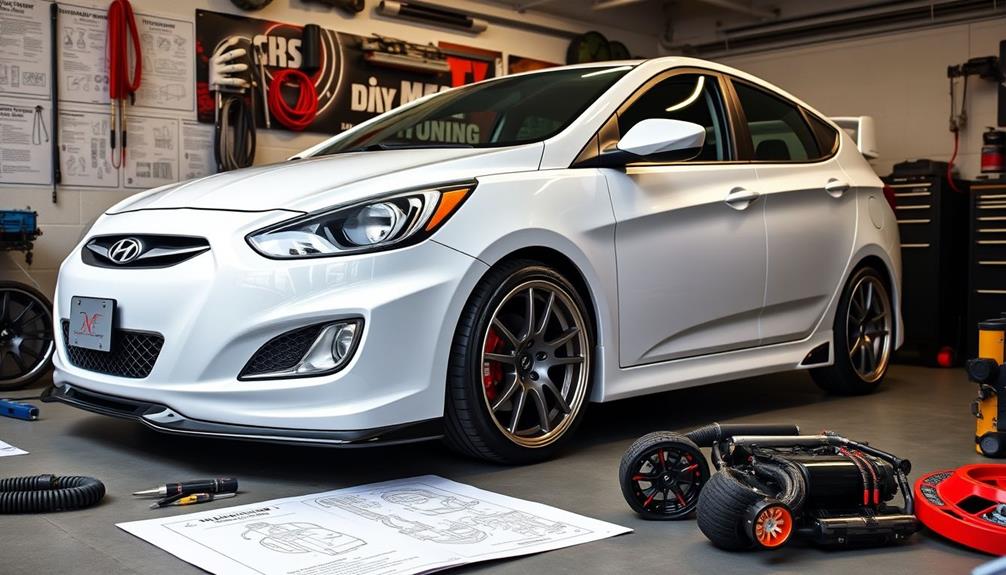
When you're looking to enhance your 2010 Hyundai Accent, DIY modifications can be a rewarding way to boost performance and personalize your ride. One great starting point is installing a cold air intake. This upgrade notably improves airflow, leading to better engine performance. You'll find specific options that fit your Accent perfectly.
If you're feeling adventurous, consider the spring valve delete mod. A step-by-step guide is available, and all you'll need are a 12mm socket and an 11mm wrench.
Just remember, when making any modifications, properly capping hydraulic lines is vital. This step prevents fluid leaks and maintains the integrity of your system.
After completing your modifications, don't forget to bleed the hydraulic system using the gravity bleeding method. This guarantees any air is removed, optimizing performance.
Regular test drives are important after each mod to assess improvements and confirm everything operates as intended. With these DIY modifications, you'll not only enhance the performance of your Hyundai Accent but also enjoy the satisfaction of personalizing your ride just the way you like it.
Community Resources and Support
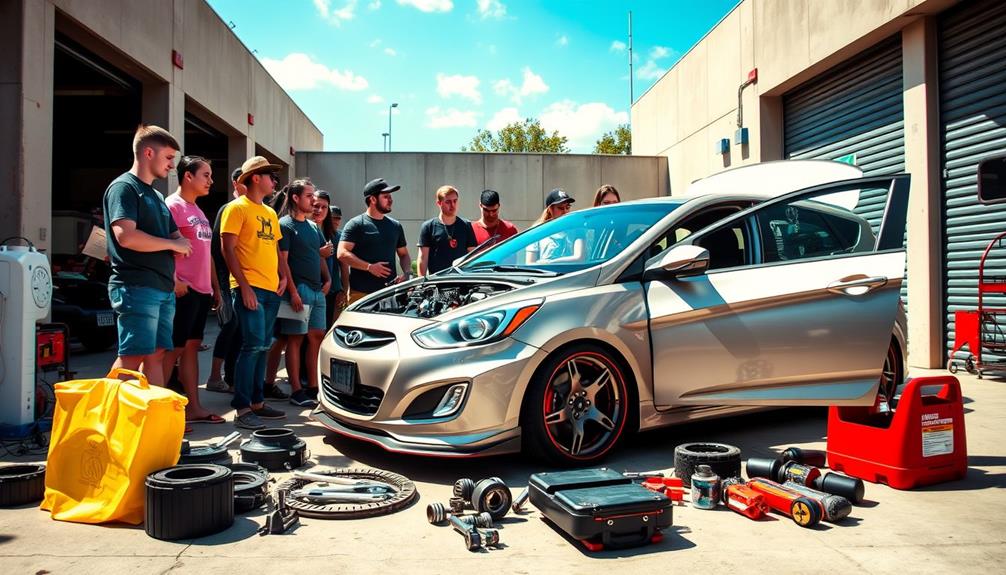
The Hyundai Accent community is a vibrant hub of enthusiasts dedicated to tuning and modifications, offering a wealth of resources and support for both seasoned modders and newcomers alike.
With over 61,000 members and 807,000 posts, you'll find endless opportunities to engage in community discussions that revolve around popular modifications like turbo kits, exhaust systems, and suspension upgrades.
Here are some ways the community can enrich your tuning journey:
- Invaluable DIY guides that empower you to take on projects with confidence.
- Step-by-step tutorials from experienced members that simplify complex modifications.
- Networking opportunities at local meet-ups, where you can share your passion and learn from others.
- A supportive environment that fosters camaraderie among car enthusiasts.
- A treasure trove of shared experiences that help you avoid common pitfalls in tuning.
Whether you're looking for advice on specific mods or just want to share your journey, the Accent community is here to support you.
Immerse yourself in the wealth of knowledge and feel the thrill of connecting with fellow enthusiasts who share your passion for performance enhancements.
Safety and Maintenance Tips

Tuning your 2010 Hyundai Accent can enhance its performance, but it's equally important to prioritize safety and maintenance. Your Accent comes equipped with six airbags and features like front seatbelt pretensioners, which greatly improve occupant protection during collisions. According to IIHS data, these features can reduce fatalities by over 45%.
To maintain safety, keep up with regular maintenance. Change your oil frequently and monitor coolant levels to prevent overheating. Properly inflated tires not only enhance performance but also guarantee your safety on the road.
If you've tuned your brakes, make sure you're using high-quality brake pads that meet local regulations to avoid voiding your warranty. If your model includes the Anti-lock Braking System (ABS) with Electronic Brake-force Distribution, take extra care to verify its functionality, as it improves braking performance during emergencies.
Always double-check that any modifications comply with local laws and don't compromise critical systems. By focusing on safety and maintenance, you'll enjoy a well-tuned vehicle without risking your well-being or that of your passengers. Make these tips part of your routine to keep your Hyundai Accent in top shape.
Future of the Hyundai Accent

As we look ahead, it's clear that the Hyundai Accent, despite its discontinuation in 2022, will continue to hold a special place in the hearts of car enthusiasts and budget-conscious buyers alike.
Its reputation for affordability, reliability, and impressive build quality guarantees that it remains a sought-after option in the used car market.
You might find yourself reminiscing about:
- The thrill of your first drive in an Accent
- The satisfaction of fuel-efficient commutes
- The joy of customizing with aftermarket modifications
- The community of passionate Accent owners
- The memories created on the road with friends and family
While the automotive landscape shifts towards SUVs and crossovers, the Accent's legacy will endure.
Even with Hyundai's newer models like the Venue and Elantra, none truly replicate the unique blend of practicality and value that the Accent offered.
Enthusiasts continue to explore aftermarket modifications, enhancing performance and keeping the spirit of the Accent alive.
As you navigate the future, whether you're hunting for a used Accent or considering modifications, know that this beloved subcompact will always hold a special spot in the automotive world. With its reliable reputation and affordable price point, the Hyundai Accent has long been a favorite among drivers looking for efficiency and practicality. And for those seeking a little extra power and flair, there are endless possibilities for enhancing the driving experience with Hyundai Accent performance upgrades. Whether you’re interested in boosting horsepower, improving handling, or simply personalizing the look of your Accent, the aftermarket options are varied and abundant. No matter which direction you take, the versatility and charm of the Hyundai Accent are sure to endure for years to come.
Frequently Asked Questions
Can You Upgrade a Hyundai Accent?
Yes, you can upgrade a Hyundai Accent. Consider enhancing its performance with a K&N air filter, a free flow exhaust system, or upgraded suspension components. Regular maintenance guarantees peak performance post-modification, keeping your ride enjoyable and responsive.
Is Hyundai Accent a Subcompact Car?
Yes, the Hyundai Accent is a subcompact car. Its compact design and efficient fuel economy make it ideal for urban driving. You'll appreciate its spacious interior and practicality, especially for city commuting and everyday use.
Can You Tune a Hyundai?
Absolutely, you can tune a Hyundai! By upgrading components and optimizing the ECU, you'll release your car's potential, transforming it from a humble ride into a thrilling machine that'll leave others in the dust.
What Is the Top Speed of the Hyundai Accent Without the Limiter?
Without the speed limiter, you can reach a top speed of around 120 mph in a Hyundai Accent. Keep in mind, though, modifications may affect safety and warranty, so weigh your options carefully.
Conclusion
Tuning your 2010 Hyundai Accent transforms it from a humble subcompact into a spirited performer. While it might look like a city commuter, with the right upgrades, it becomes a nimble racer, keenly taking on the open road. Picture the smooth rumble of a tuned exhaust juxtaposed with the quiet hum of factory settings. As you enhance its power and handling, you're not just modifying a car; you're releasing its true potential, turning everyday drives into thrilling experiences.
Alex is our go-to expert on performance tuning, with over a decade of experience in the automotive industry. His deep understanding of engine dynamics, exhaust systems, and performance software allows him to break down complex concepts into easy-to-follow guides. Whether you’re looking to boost horsepower or fine-tune your vehicle’s responsiveness, Alex’s insights will help you achieve peak performance.
Hyundai Tuning
Hyundai Sonata 2017 Tuning: Maximizing Power and Efficiency in Your Sedan
Maximize your 2017 Hyundai Sonata’s power and efficiency with expert tuning tips that could transform your driving experience—discover the secrets inside!

Tuning your 2017 Hyundai Sonata can greatly enhance both power and efficiency. Start with an ECU remap, which can boost horsepower by about 10-15. Adding a high-flow K&N air intake and performance exhaust system further improves airflow and torque. Consider upgrading to an electronic throttle controller to enhance throttle response. While basic modifications can cost between $500 and $700, they can yield impressive gains. Joining the Hyundai community can provide invaluable support and advice. Discovering more options for upgrades can take your driving experience to the next level and make all the difference in performance.
Key Takeaways
- Upgrade to a cold air intake system and K&N air filter to enhance airflow, boosting horsepower and torque by up to 10%.
- Consider ECU remapping and performance chip modules for increased horsepower up to 20 and improved fuel efficiency.
- Install a performance exhaust system to enhance sound and engine efficiency, adding around 10 horsepower and 7 lb-ft torque.
- Improve throttle response with electronic throttle controllers for a more engaging and responsive driving experience.
- Engage with the Hyundai community for tips, DIY projects, and support on tuning modifications to maximize your Sonata's performance.
Performance Gains Overview
When you tune the stock 2.4L GDI engine in the 2017 Hyundai Sonata, you can expect noticeable performance gains. From a BTR dyno test, you could see an increase of about 10 horsepower and 7 torque.
If you opt for an ECU tune, like the LAP3, you can release even more power while improving fuel efficiency and optimizing your engine's air-fuel ratios.
For those looking for significant enhancements, simple modifications such as exhaust headers and a K&N air intake system can elevate your Sonata to over 200 horsepower.
Additionally, porting and polishing the engine head might provide a potential boost of up to 30 horsepower, although you'll want to be cautious about costs.
Improving throttle response is also essential for performance. By utilizing electronic throttle controllers like the TROS Potent Booster, you can enhance your driving experience without necessarily increasing horsepower or torque.
Essential Modifications for Power

When it comes to boosting your 2017 Hyundai Sonata's power, certain modifications can make a significant difference.
You'll want to contemplate upgrades like a cold air intake, performance chip, and aftermarket exhaust to maximize performance gains.
We'll also weigh the costs against the benefits to help you make informed decisions on your tuning journey.
Performance Gains Overview
Tuning the 2017 Hyundai Sonata can transform your daily driver into a more spirited performer. By implementing a few essential modifications, you can achieve noticeable gains in engine performance.
Start with a cold air intake system, which can optimize air intake and potentially boost horsepower and torque by up to 10%. Pair this with a high-performance K&N air filter to maximize airflow.
Next, consider upgrading to a performance exhaust system, like a 3-inch setup with resonator delete. This not only enhances the sound but also improves engine efficiency, contributing to overall performance gains. With these modifications, you might see an increase of around 10 horsepower and 7 lb-ft of torque.
For even greater throttle response, installing an electronic throttle controller, such as the TROS Potent Booster, can greatly improve your driving experience without directly impacting horsepower.
Finally, for those looking for a more advanced option, porting and polishing the engine head can yield an additional potential gain of around 30 horsepower, though this requires careful execution to avoid high costs.
Embrace these modifications, and you'll feel the difference every time you hit the road.
Recommended Upgrade Components
In order to maximize power and performance in your 2017 Hyundai Sonata, it's important to evaluate several key upgrades that can greatly enhance your driving experience.
By focusing on specific components, you can access the full potential of your sedan.
Here are three essential modifications to take into account:
1. Air Intake: Upgrading to a K&N air filter and cold air intake system can greatly improve airflow, boosting horsepower by up to 10% in your Sonata's 2.4L engine.
This enhancement not only increases power but also enhances engine efficiency.
2. Performance Chip: Installing a performance chip module can reveal hidden engine power, potentially increasing horsepower by up to 20 and torque by 25 lb-ft.
Additionally, you'll benefit from improved fuel economy, gaining up to 4 mpg.
3. Throttle Body: Think about upgrading to a larger throttle body.
This modification improves throttle response and overall acceleration, making your Sonata feel more responsive and enjoyable to drive.
Cost Vs. Benefits Analysis
Evaluating the costs versus the benefits of modifications for your 2017 Hyundai Sonata can help you make informed decisions about enhancing performance.
Basic upgrades, like a performance chip and cold air intake, can provide gains of up to 20 horsepower and 25 lb-ft of torque, all for a cost of around $500 to $700. This investment can greatly boost your engine's performance without the hefty price tag of a new vehicle.
Installing a K&N air filter and custom ECU reflash can optimize your air intake efficiency, enhancing throttle response and possibly improving fuel economy by up to 4 mpg.
Additionally, upgrading to a high-flow exhaust system, including headers and a 3-inch exhaust with resonator delete, can net you around 10 more horsepower and 7 lb-ft of torque.
While it's tempting to chase peak power, community insights suggest focusing on torque delivery across the RPM range for non-turbo models like the Sonata is often more beneficial.
Enhancing Throttle Response

Improving throttle response can transform your driving experience, making it more engaging and responsive. When your Sonata's throttle response is enhanced, you'll notice a more immediate reaction when you press the gas pedal.
Here are some effective methods to achieve this:
- Install a TROS Potent Booster or Sprint Booster: These devices adjust the gas pedal voltage, increasing sensitivity without altering horsepower or torque directly.
- Consider a Pedal Commander: This electronic throttle controller improves responsiveness and eliminates lag, all without hardware modifications.
- Upgrade to a K&N air intake system: By optimizing airflow to the engine, you complement throttle response enhancements, leading to better overall performance.
Regular ECU tuning is also essential. By adjusting ignition timing and air-fuel ratios, you'll further refine throttle response, creating a more dynamic and engaging driving feel.
With these modifications, you can enjoy a sporty, responsive ride that brings excitement back to your daily drive. Making these upgrades not only boosts throttle response but also improves your Sonata's overall efficiency and performance.
Cost and Budget Considerations

Upgrading your 2017 Hyundai Sonata can be an exciting journey, but it's important to keep your budget in check as you explore performance modifications.
Start by determining how much you're willing to invest. Basic modifications like chip tuning and supporting mods typically range from $500 to $700. If you're eyeing advanced options like cams and pulleys, you might add another $400 to $500 to your total.
For those craving considerable power gains, a T4 Turbo kit will set you back around $5,000, which can greatly impact your overall tuning budget. However, there's a silver lining—trading in your original parts can help offset these costs. Many dealerships offer better trade-in values, making it a smart financial strategy.
Consider more budget-friendly enhancements too. Upgrading to a K&N air filter or a 3-inch exhaust system can improve performance without breaking the bank, often costing between $200 and $500 each.
Community Support and Resources
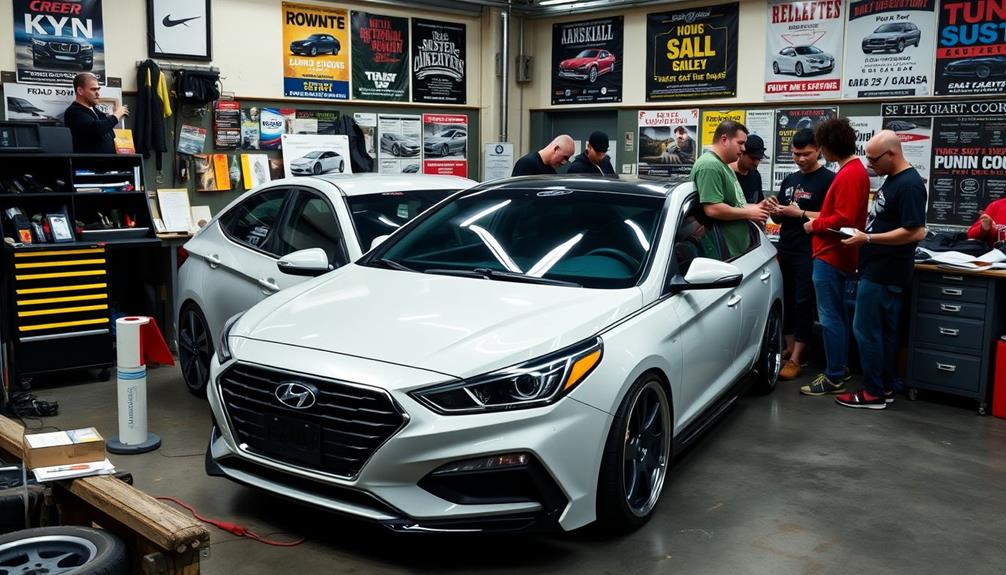
The tuning journey for your 2017 Hyundai Sonata can be greatly enhanced by tapping into community support and resources. Engaging with fellow enthusiasts not only broadens your knowledge but also offers practical insights on performance tuning and modifications.
Here are three key resources to evaluate:
- Hyundai Forum: This platform is essential for Sonata owners. You can exchange experiences, ask questions, and gain valuable advice on everything from air intakes to ECU tuning.
- Online Video Playlists: There are numerous guides available that provide step-by-step instructions for DIY tuning projects, including electric turbo installations. These resources make it easier for you to tackle modifications confidently.
- Local Support Groups: Connecting with local tuners can be incredibly helpful. They often provide hands-on assistance with machining and electronic upgrades, creating a collaborative learning environment.
Stages of Engine Tuning
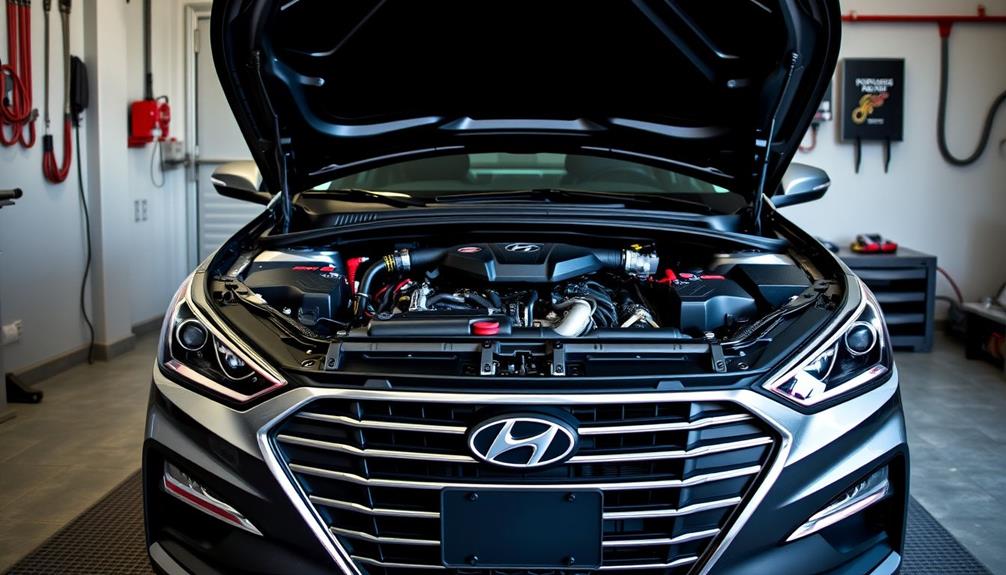
When it comes to tuning your 2017 Hyundai Sonata, understanding the different stages of engine modifications is essential for achieving your performance goals.
Stage 1 tuning usually starts with remapping the ECU, installing a sports exhaust, and upgrading to lightweight alloy wheels. These changes can boost your power levels by about 10-15 horsepower and improve throttle response.
Moving on to Stage 2 tuning, you'll focus on more advanced modifications like ported heads, fuel pump upgrades, and high-flow injectors. This can yield gains of 20-30 horsepower and enhance torque characteristics.
For those looking for serious performance, Stage 3 tuning introduces forced induction upgrades and internal engine modifications. This stage can see power increases of 30-50 horsepower but requires significant investment and expertise.
Frequently Asked Questions
How Often Should You Get a Tune up on a Hyundai Sonata?
You should get a tune-up for your Hyundai Sonata every 30,000 to 60,000 miles. Regular check-ups help maintain performance, fuel efficiency, and can prevent costly repairs, ensuring your vehicle runs smoothly over time.
Can You Modify a Sonata?
Absolutely, you can transform your Sonata into a powerhouse! By modifying components like the ECU, cold air intake, and exhaust system, you'll boost performance and enjoy an exhilarating driving experience you won't forget.
What Is the Fuel Efficiency for a Hyundai Sonata?
The fuel efficiency for a Hyundai Sonata varies by engine type. The 2.4L achieves 26 mpg city and 36 mpg highway, while the 2.0L turbo offers 23 mpg city and 32 mpg highway.
What Is the Most Powerful Hyundai Sonata?
The most powerful Hyundai Sonata is the 2017 Sonata Sport 2.0T, boasting 245 horsepower and 260 lb-ft of torque. It's equipped with a turbocharged engine that enhances both performance and efficiency for an engaging driving experience.
Conclusion
To sum up, tuning your 2017 Hyundai Sonata can greatly boost both power and efficiency. With the right modifications and a clear budget, you'll not only enhance your driving experience but also enjoy the journey. Remember, "a journey of a thousand miles begins with a single step." So, whether it's upgrading your exhaust or improving throttle response, take that first step and watch your sedan transform into a more dynamic ride. Happy tuning!
Alex is our go-to expert on performance tuning, with over a decade of experience in the automotive industry. His deep understanding of engine dynamics, exhaust systems, and performance software allows him to break down complex concepts into easy-to-follow guides. Whether you’re looking to boost horsepower or fine-tune your vehicle’s responsiveness, Alex’s insights will help you achieve peak performance.
Hyundai Tuning
Hyundai Azera Tuning: Enhancing Power and Luxury in Your Sedan
You can transform your Hyundai Azera into a powerhouse of performance and luxury; discover the essential upgrades that can elevate your driving experience.

Tuning your Hyundai Azera can elevate both its power and luxury, making for an exhilarating driving experience. By adding a cold air intake and a freer-flowing exhaust, you can boost horsepower by 15-30 HP. ECU tuning further enhances torque and throttle response. Don't forget about suspension upgrades like coilovers and performance tires, which improve handling and stability. Balancing comfort and performance is key. Make sure you consider your budget, as effective modifications start around $1,500. The journey to a superior Azera is exciting, and there's much more to explore about how to achieve peak performance and comfort.
Key Takeaways
- Performance modifications like cold air intakes and ECU tuning can boost the Hyundai Azera's horsepower by 15-30 HP and torque by 40 lb-ft.
- Upgrading suspension with coilovers and high-performance tires enhances handling, stability, and overall driving experience.
- Proper tuning and regular maintenance are crucial to avoid engine damage and ensure reliability after modifications.
- Safety is paramount; high-speed driving requires upgraded tires and careful consideration of vehicle stability.
- Engaging with the Hyundai Azera community provides valuable insights and support for tuning and maintenance.
Performance Modifications Overview
When it comes to tuning your Hyundai Azera, performance modifications can take your driving experience to the next level. By focusing on performance upgrades, you can considerably boost horsepower and torque, enhancing both acceleration and overall enjoyment.
Consider installing a cold air intake and a freer-flowing exhaust system to improve engine airflow. This not only elevates throttle response but can also enhance fuel efficiency, allowing you to enjoy spirited driving without sacrificing economy.
Upgrading your stock transmission is vital, as the original may limit the gains from your modifications. Additionally, adding coilovers and high-performance tires will improve handling and stability, making your Azera safer during spirited driving.
You can realistically expect performance gains of 15-30 horsepower from these upgrades, creating a more engaging driving experience.
Engine Specifications and Tuning
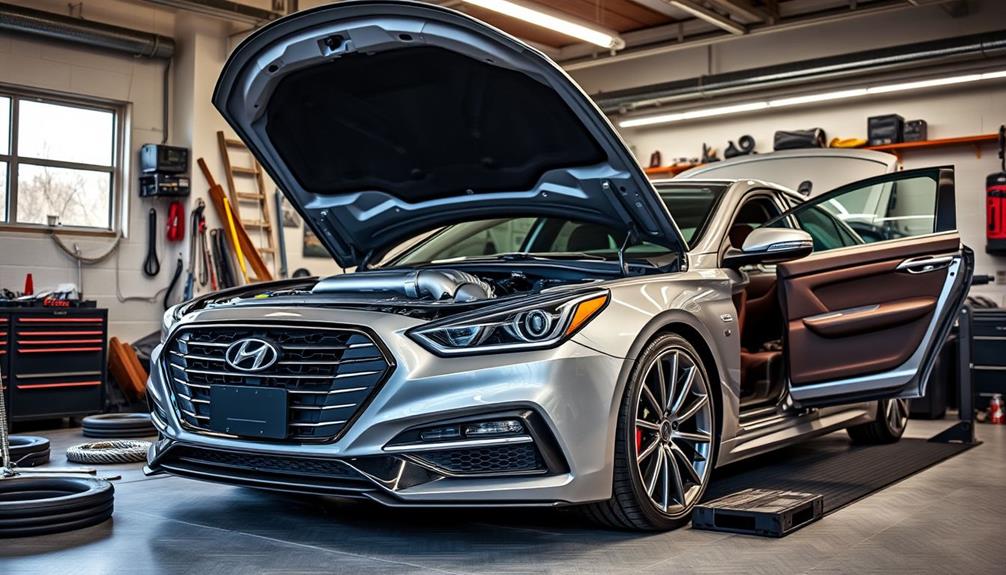
When tuning your 2013 Hyundai Azera, understanding the engine's specifications is essential for maximizing performance.
You'll want to take into account enhancements like turbocharging and ECU tuning, but keep in mind the necessary modifications and potential risks involved.
Regular maintenance and high-quality fuel play significant roles in ensuring your upgraded engine runs smoothly and reliably.
Engine Performance Enhancements
To maximize the performance of your 2013 Hyundai Azera, consider several engine enhancements that can greatly boost horsepower and torque. The stock 3.3L V6 engine has potential waiting to be revealed. One effective way to enhance performance is through ECU tuning, which can yield gains of 15-30 HP and up to 40 lb-ft of torque, considerably improving throttle response and overall driving dynamics.
Upgrading to a performance chip can also reveal hidden potential with easy plug-and-play installation. Additionally, improving your air intake allows more airflow into the engine, further increasing power output.
Here's a quick overview of the potential enhancements:
| Enhancement | Potential Gains | Benefits |
|---|---|---|
| ECU Tuning | 15-30 HP, 40 lb-ft | Enhanced throttle response |
| Performance Chip | Varies by model | Reveals engine potential |
| Air Intake Upgrade | 5-15 HP | Improved airflow |
| Exhaust System | 5-10 HP | Better fuel efficiency |
| Cold Air Intake | 10-20 HP | Increased engine efficiency |
These enhancements can lead to a more powerful and efficient driving experience.
Tuning Considerations and Risks
Before diving into tuning your 2013 Hyundai Azera, it's crucial to weigh the considerations and risks associated with modifying engine specifications.
While tuning can offer significant performance upgrades, not all modifications guarantee safety or reliability. Here are three key factors to keep in mind:
- Engine Integrity: Your Azera's 3.3 V6 engine has a high compression ratio of 11.5:1, which complicates turbocharging. Without proper tuning, you risk detonation, leading to costly engine damage.
- ECU Tuning: Enhancing the ECU can yield an extra 15-30 horsepower and boost torque by up to 40 lb-ft. However, this must be done carefully. Inadequate tuning can jeopardize your engine's longevity and performance.
- Fuel Mixture Management: Achieving effective performance gains requires a solid understanding of fuel grade, temperature, and cylinder pressure.
An improper fuel mixture can result in poor performance and detonation issues.
Turbocharging Options and Considerations

Turbocharging the Hyundai Azera offers a compelling way to boost performance, but it comes with specific factors to take into account. Using a turbo from a Genesis Coupe is feasible, but you'll need to verify compatibility with your stock internals to maintain engine reliability. Here's a quick overview of the key aspects to keep in mind:
| Factor | Details |
|---|---|
| Compatibility | Verify turbo fits stock internals |
| Modifications | Tune, upgraded exhaust, free-flowing intake |
| Compression Ratio | High compression (11.5:1) requires careful tuning |
You'll also need to take into account relocating components like the battery due to space constraints. Proper tuning post-turbocharging is essential for enhancing your engine's longevity and performance. It's advisable to use low boost pressure to mitigate detonation risks.
Finding aftermarket support can be tricky since options for the Azera are limited compared to sportier models. Engaging with the community for insights can make a significant difference in your tuning experience. By keeping these aspects in mind, you can enjoy the benefits of turbocharging while minimizing potential issues.
ECU Tuning and Performance Chips
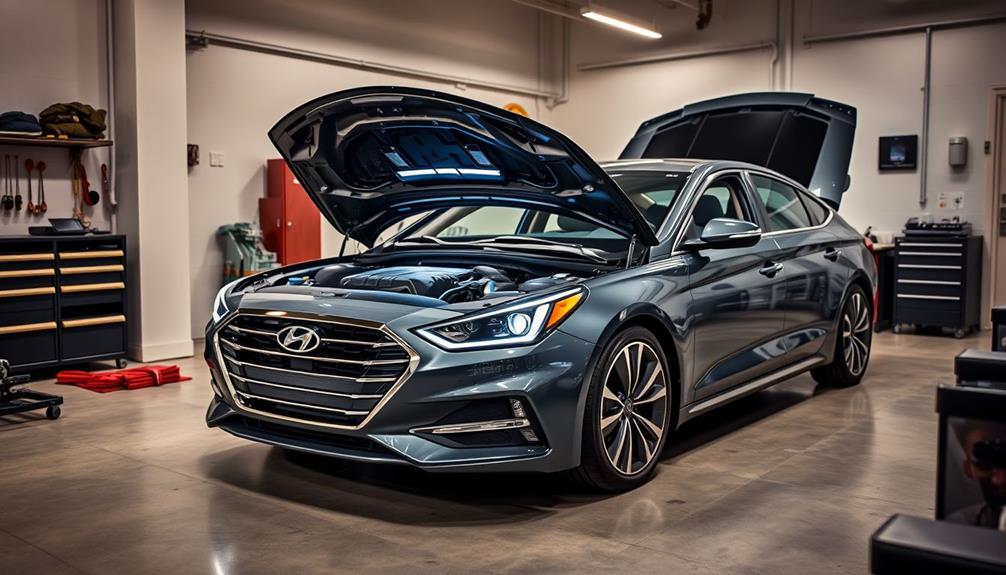
When you're considering ECU tuning and performance chips for your Hyundai Azera, you'll notice several benefits, like increased horsepower and torque.
However, it's crucial to weigh the risks associated with tuning against alternative power enhancements.
Let's explore how you can optimize your ride while keeping your vehicle safe and efficient.
Performance Chip Benefits
Performance chips offer a straightforward way to boost your Hyundai Azera's engine performance. By optimizing your vehicle's ECU settings, these chips can increase horsepower by 15-30 and torque by up to 40 lb-ft.
Plus, their installation is user-friendly, typically involving a simple plug-and-play setup that maintains your warranty.
Here are three key benefits of using performance chips:
- Improved Throttle Response: Experience quicker acceleration and better drivability, making every drive more enjoyable.
- Enhanced Fuel Economy: Many users report fuel savings of up to 4 mpg, thanks to optimized fuel-air mixtures that improve efficiency without sacrificing power.
- Customer Satisfaction: Most performance chips come with money-back guarantees, allowing you to try them without risking your engine's safety.
With these advantages, performance chips make it easier to elevate both the power and luxury of your Hyundai Azera.
Risks of ECU Tuning
ECU tuning can offer impressive power gains, but it's essential to recognize the risks involved. While you might enjoy horsepower increases of 15-30 HP and torque enhancements of up to 40 lb-ft, improper tuning can lead to engine damage or even failure.
Many users have reported reliability issues with performance chips, and these can void your manufacturer warranty, complicating future repairs.
One of the significant risks of ECU tuning lies in installation errors. Without professional expertise, you could accidentally cause severe engine issues, negating any potential power increase.
Furthermore, modifying your ECU can alter your vehicle's stability and handling, which might impact your insurance coverage in the event of an accident.
Don't forget about emission regulations either. Tuning your ECU may push your vehicle out of compliance with local environmental laws, leading to potential fines or legal issues.
Alternative Power Enhancements
For Hyundai Azera owners looking to boost their vehicle's performance, alternative power enhancements like ECU tuning and performance chips can be game changers.
These modifications not only elevate horsepower and torque but also enhance the driving experience.
Here's what you can expect from these enhancements:
- Increased Power: ECU tuning can add 15-30 horsepower and up to 40 lb-ft of torque, making your Azera feel more responsive.
- Improved Throttle Response: With performance chips like the Stage 3 OBDII module, you'll enjoy quicker acceleration and an overall more engaging drive.
- Fuel Savings: Upgrading can improve fuel efficiency, potentially saving you up to 4 miles per gallon, depending on your driving conditions.
Both ECU tuning and performance chips prioritize safety and engine health, ensuring that you can enhance performance without compromising reliability.
By opting for these alternative power enhancements, you not only release your Azera's hidden potential but also enjoy a more luxurious and thrilling driving experience.
Embrace these upgrades and feel the difference on every drive!
Suspension and Handling Upgrades

When it comes to enhancing the Hyundai Azera's suspension and handling, upgrading components like coilovers can make a noticeable difference.
Coilovers allow you to adjust ride height and improve suspension stiffness, which helps maintain stability at higher speeds. This upgrade can dramatically enhance your driving experience, especially during spirited driving.
Don't overlook the importance of upgraded tires. While OEM tires are rated for speeds up to 149 mph, performance tires offer better grip and responsiveness, which are vital for high-speed stability and safety.
Additionally, consider solid or urethane motor mounts to reduce engine movement. This improvement enhances power transfer to the wheels, boosting overall handling and performance during acceleration.
Incorporating suspension modifications like sway bars can also reduce body roll during cornering, giving you a more controlled and engaging driving experience.
It's essential to strike a balance between comfort and performance, so look for suspension upgrades that enhance handling without sacrificing ride quality.
Cost and Budget for Modifications
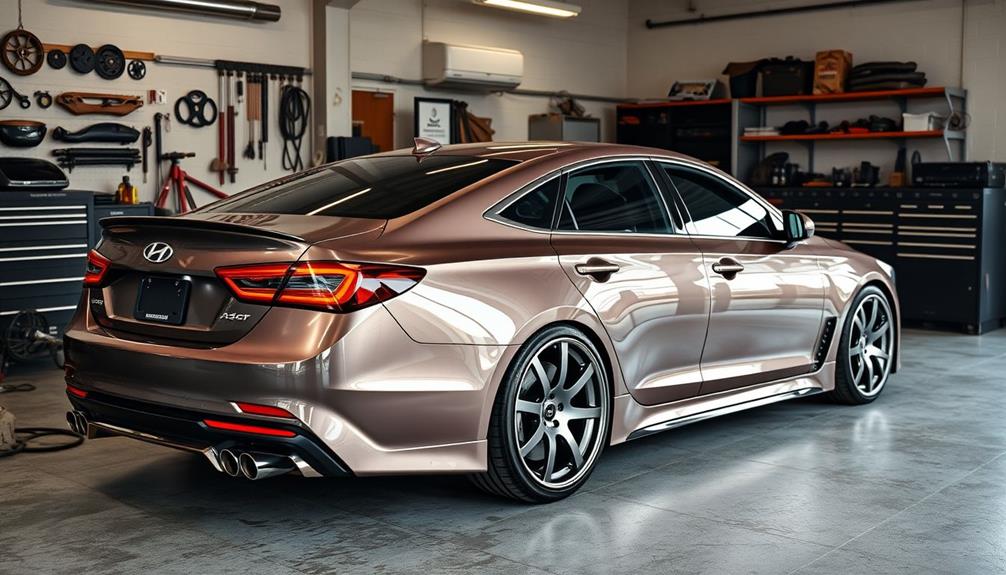
Tuning your Hyundai Azera can be an exciting venture, but it's essential to plan your budget wisely.
You'll want to guarantee you can afford the modifications that will enhance performance without breaking the bank. Here's a quick breakdown of potential costs to evaluate:
- Basic Modifications: Starting with engine and suspension tweaks, expect to spend around $1,500. For significant enhancements, aim for a budget of approximately $3,000.
- Performance Upgrades: If you're eyeing options like porting, supercharging, or exhaust modifications, be prepared for additional expenses. These performance upgrades often involve complex changes that can quickly add to your budget.
- High-Quality Parts: Investing in quality aftermarket parts and professional installation can further increase your total cost. Remember, significant engineering changes, like a standalone engine management system, can substantially raise your expenditure.
To maintain a balance between performance and luxury, focus on modifications that enhance your driving experience without compromising comfort.
Safety and Speed Considerations

Modifying your Hyundai Azera for speed can be thrilling, but it's important to keep safety in mind. Achieving speeds over 90 mph is generally considered unsafe under most conditions, so moderation in your performance enhancements is significant.
While the manufacturer claims a top speed of 160 mph, verified testing shows a maximum of 153 mph on flat roads. High-speed driving naturally increases the risk of accidents, especially on uneven surfaces, making defensive driving techniques crucial.
When you pursue performance improvements like porting and supercharging, be aware that they can elevate the risk factor. The stock transmission might limit your speed capabilities, which often necessitates a custom transmission for significant gains.
Additionally, don't overlook the importance of upgraded tires rated for high speeds; OEM tires are only rated for up to 149 mph. This enhancement is important for maintaining stability and ensuring your safety at elevated speeds.
Ultimately, prioritizing safety while tuning your Azera for performance will allow you to enjoy the thrill of high-speed driving without compromising your well-being.
Always remember, speed is exhilarating, but safety should always come first.
Community Resources and Support
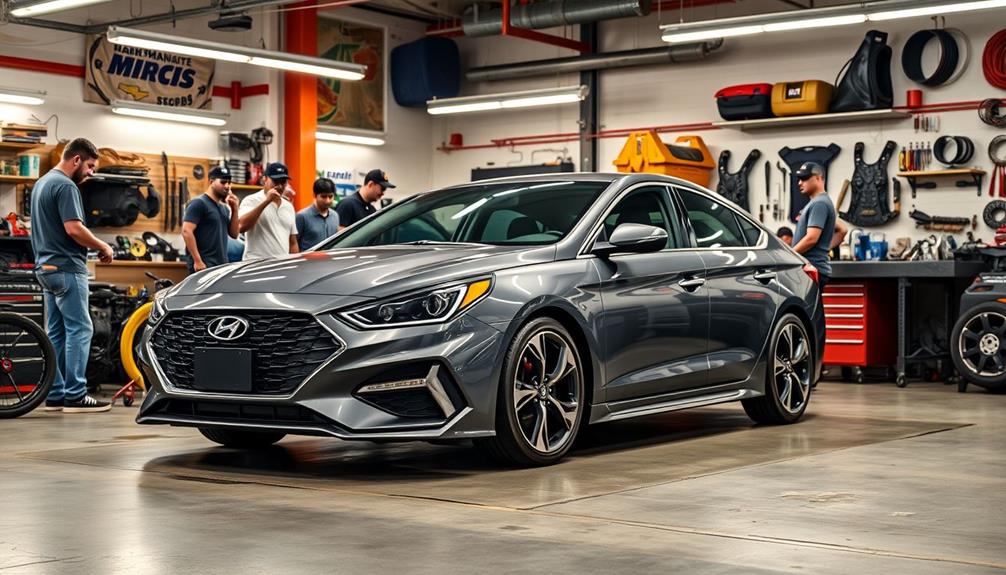
Finding support and resources within the Hyundai Azera community can markedly enhance your tuning journey.
With over 807.3K posts and 61.4K members, this vibrant forum community is packed with valuable insights from fellow owners and enthusiasts. Engaging with this community not only helps you gather knowledge but also fosters connections with like-minded individuals who share your passion.
Here are three key resources to leverage:
- Tuning Threads: Engage in discussions about tuning modifications and maintenance tips. You'll find a treasure trove of shared experiences that can guide your decisions.
- Safety Recommendations: Take note of advice emphasizing safety in high-speed driving. Many members advocate for dedicated track cars when pursuing performance goals, ensuring a responsible approach to tuning.
- Maintenance Insights: Regular maintenance is essential for the longevity of your Azera. Community members often share stories, like a 2007 Azera reaching 316,000 miles, which highlight the importance of caring for your vehicle.
Aftermarket Parts and Upgrades

Upgrading your Hyundai Azera with aftermarket parts can transform your driving experience, delivering enhanced performance and efficiency. One of the best investments you can make is a cold air intake. This modification considerably improves airflow to your engine, resulting in a noticeable boost in horsepower and torque.
Coupled with performance ECU tuning, you can gain an additional 15-30 horsepower and up to 40 lb-ft of torque, optimizing ignition timing and enhancing throttle response.
Installing a freer-flowing exhaust system and upgraded headers further enhances engine performance while reducing back pressure, leading to improved acceleration. Lightweight crank pulleys and high-performance spark plugs are also effective upgrades that enhance engine efficiency without compromising safety.
If you're looking to fine-tune your driving experience, consider adding a Pedal Commander device. This little gadget offers customizable driving modes that improve throttle response and fuel efficiency, all while being easy to install and maintaining your manufacturer's warranty.
With these aftermarket parts and upgrades, you'll not only boost the Azera's performance but also enjoy a more engaging and luxurious driving experience.
Frequently Asked Questions
Is the Hyundai Azera Fast?
The Hyundai Azera isn't the fastest sedan on the market. While it offers decent performance with a top speed around 153 mph, achieving extreme speeds requires significant modifications and could compromise safety and reliability.
Why Is Hyundai Azera Discontinued?
In 2016, full-size sedan sales dropped by 29%, pushing Hyundai to discontinue the Azera. You'll find automakers focusing on SUVs and crossovers, as consumer preferences shifted towards larger, more versatile vehicles.
What Car Is Comparable to a Hyundai Azera?
If you're considering alternatives to the Hyundai Azera, look into the Kia Cadenza, Toyota Avalon, Chevrolet Impala, Nissan Maxima, or Ford Taurus. Each offers luxury, space, and performance that might suit your needs perfectly.
How Many Miles Can You Put on a Hyundai Azera?
With proper care, your Hyundai Azera can achieve astonishingly high mileage, often exceeding 200,000 miles. Regular maintenance and premium fuel play pivotal roles in preserving performance and prolonging the life of your reliable ride.
Conclusion
In the domain of performance sedans, tuning your Hyundai Azera can transform it from a mere chariot into a sleek stallion, galloping ahead of the pack. With a keen eye on power and luxury, you can elevate your driving experience to new heights. So, embrace the art of modification and let your Azera shine like a diamond in the rough. Remember, every great journey begins with a single upgrade—make yours unforgettable.
Alex is our go-to expert on performance tuning, with over a decade of experience in the automotive industry. His deep understanding of engine dynamics, exhaust systems, and performance software allows him to break down complex concepts into easy-to-follow guides. Whether you’re looking to boost horsepower or fine-tune your vehicle’s responsiveness, Alex’s insights will help you achieve peak performance.
Hyundai Tuning
Hyundai Accent 2004 Tuning: Unlocking the Full Potential of Your Subcompact Car
Fuel your passion for performance as you explore how to transform your 2004 Hyundai Accent into an exhilarating driving machine. Discover the possibilities ahead!

Tuning your 2004 Hyundai Accent can radically enhance its performance, turning it into a fun-to-drive subcompact. Start with suspension upgrades like lowering springs or coilovers for improved handling. Consider an upgraded exhaust system and a cold air intake to boost power and efficiency. If you're ready for a bigger change, think about an engine swap or turbocharging for significant horsepower gains. Don't overlook performance chips and high-quality spark plugs to guarantee peak engine function. Each modification adds a unique benefit, paving the way for a more thrilling ride. Discover how to maximize your tuning journey and make your Accent stand out. In addition, lightweight aftermarket wheels and high-performance tires can further elevate your car’s agility and responsiveness. Interior enhancements such as upgraded seats and a racing steering wheel can also enhance your driving experience. Whether it’s a 2004 or you’re diving into Hyundai Accent 2003 tuning, the same principles apply—small, well-chosen mods can transform your daily driver into an exhilarating machine.
Key Takeaways
- Upgrade the suspension with lowering springs or coilovers for improved handling and cornering stability in your Accent.
- Install a cold air intake and performance exhaust system to enhance airflow and increase horsepower and torque.
- Consider an engine swap to the 2.0L Beta engine for significant power improvements over the stock 1.6L engine.
- Turbocharging the Accent can dramatically boost horsepower and torque, providing a responsive driving experience.
- Utilize performance chips and diagnostic tools to optimize engine performance and monitor modifications effectively.
Suspension Modifications
When it comes to enhancing the performance of your 2004 Hyundai Accent, suspension modifications are a game-changer. By upgrading your suspension, you can dramatically improve both handling and ride quality.
Start with lowering springs like B&G or Eibach, which drop your car by 1.7 inches and 1.2 inches, respectively. This gives your Accent a more aggressive stance and better cornering abilities.
If you want to take it a step further, consider installing coilovers. They allow you to lower your vehicle beyond 2 inches, plus you can adjust both ride height and dampening to suit your driving style.
Replacing stock struts with KYB GR2 gas struts also enhances handling performance, providing improved stability during turns.
To boost chassis rigidity, install front and rear strut bars. These modifications are straightforward and cost-effective, contributing notably to cornering stability.
Finally, adding a rear sway bar, such as the Ultra Racing option, can further stabilize your vehicle during turns.
With these suspension modifications, you'll reveal the full potential of your Hyundai Accent, transforming it into a sportier and more responsive ride.
Exhaust System Upgrades

Upgrading the exhaust system on your 2004 Hyundai Accent can considerably enhance both engine performance and sound. One effective option is to install a catback exhaust system, like the Evofusion model, which not only improves sound but also provides slight performance boosts. If you're looking for more power, consider adding headers; however, be aware that this might lead to a louder exhaust note and could trigger the check engine light if not paired with a catalytic converter.
Here's a quick comparison of popular exhaust upgrades:
| Upgrade Type | Benefits | Considerations |
|---|---|---|
| Catback System | Better sound, slight performance | Minimal installation effort |
| Headers | Significant power increase | May cause check engine light |
| Catalytic Converter | Emission compliance | Removal causes issues |
| Exhaust Tips | Custom look | Minimal performance impact |
| Full System Upgrade | Maximum performance | Higher investment |
Combining these exhaust system upgrades with other performance modifications is essential for maximizing horsepower and torque. Remember, regular maintenance and assessment of your exhaust system are vital to ensuring peak performance and compliance with local emissions laws.
Intake System Improvements

A well-designed intake system can greatly boost your 2004 Hyundai Accent's performance. One of the best options is a Cold Air Intake (CAI), which allows cooler, denser air to enter the combustion chamber. This results in improved horsepower and torque, giving your engine a noticeable performance upgrade.
If you're looking for a more budget-friendly option, consider short ram intakes. While they can enhance throttle response, they may draw in warmer air, which could limit your overall gains.
To maximize airflow, installing a high-flow air filter alongside your new intake system is vital. This addition can lead to slight improvements in fuel economy and acceleration, making your car even more responsive.
Remember, proper installation of your intake system is important. It helps mitigate issues related to warm air intake, ensuring you get the best performance possible.
If you're serious about tuning your Accent, consider combining these intake upgrades with exhaust enhancements. This synergy can yield significant performance improvements, allowing your subcompact car to truly shine.
With a few strategic modifications, you can access the full potential of your Hyundai Accent and enjoy a more exhilarating driving experience.
Engine Swap Options

When considering engine swap options for your 2004 Hyundai Accent, the 2.0L Beta engine stands out as a popular choice, offering notable performance improvements with minimal modifications.
You might also explore turbocharging, which can greatly enhance your car's power without the need for a full engine replacement.
Understanding these options will help you make the best decision for your tuning goals.
2.0L Beta Swap
Contemplating an engine swap for your 2004 Hyundai Accent? The 2.0L Beta engine is a popular choice among enthusiasts looking to boost their car's performance. Swapping out the stock 1.6L Alpha engine for the Beta can deliver significant horsepower and torque gains, giving your Accent a much-needed performance upgrade.
When planning your Beta swap, it's important to evaluate engine mounts and transmission compatibility. Some modifications may be necessary to guarantee a proper fit, so be prepared for a bit of work.
Fortunately, many enthusiasts have completed successful Beta swaps, thanks to the extensive aftermarket support available for the Beta engine platform.
Keep in mind that updating the ECU and supporting components is vital for peak performance. This will help integrate the Beta engine with your vehicle's systems, making sure everything runs smoothly after the swap.
With the right approach, you can reveal the full potential of your 2004 Hyundai Accent, transforming it into a more powerful, exciting ride. So, if you're ready to take your tuning journey to the next level, a Beta swap could be the perfect solution.
Turbocharging Advantages
Turbocharging offers a transformative upgrade for your 2004 Hyundai Accent, greatly enhancing both horsepower and torque output. By adding a turbocharger, you can experience significant performance gains—often exceeding 100 horsepower—depending on your setup and tuning. This increase in power provides a more responsive driving experience, improving acceleration and overall performance in various driving conditions.
If you're considering turbocharging, you might also want to explore engine swap options. Swapping the stock 1.6L Alpha engine for a more robust 2.0L Beta engine can be an excellent choice. The Beta engine is better suited for forced induction systems and can handle the added stress of a turbocharger more effectively.
Moreover, properly installed turbo systems can also enhance fuel efficiency. By optimizing the fuel-air mixture and promoting better combustion, you'll not only gain power but could also improve your miles per gallon.
This means you can enjoy the thrill of turbocharging without sacrificing efficiency. Overall, turbocharging, coupled with an engine swap, can release your Accent's full potential, making it a formidable performer on the road.
Performance Chip Enhancements

Performance chip enhancements can considerably elevate your 2004 Hyundai Accent's engine capabilities. By installing a performance chip, you're not just making a small tweak; you're revealing the potential for significant gains in horsepower and torque.
For instance, the Stage 3 Performance Chip OBDII Module, priced at $239.95, boasts a multi-core CPU and can release up to 30% more power, transforming your Hyundai Accent Hatchback into a more robust performer.
If you're looking for a more budget-friendly option, the Stage 1 Performance Chip Module OBD2 is available for $99.99 and is specifically designed to enhance engine performance with advanced technology tailored for your vehicle.
Additionally, consider the Mega Raizin Voltage Performance Chip at $49.99, which improves engine stability by effectively regulating voltage.
Don't overlook the Raizin Voltage Stabilizer for $44.95, ensuring peak performance during your modifications.
Each of these performance chip modules comes with a money-back guarantee, assuring you of their safety and compatibility with your Hyundai.
With these enhancements, you're well on your way to experiencing a more powerful and responsive driving experience.
Air Intake Systems

Upgrading your 2004 Hyundai Accent with an air intake system can yield impressive improvements in horsepower and torque. By enhancing airflow, a cold air intake system can greatly boost your car's performance compared to a short ram intake, which pulls in warmer air that can hinder efficiency.
Performance air intake systems are designed not just for power, but also for better fuel efficiency and acceleration. If you're looking for a cost-effective option, short ram intake kits are priced around $89.99 and can deliver up to a 10% increase in horsepower and torque. This makes them an attractive option for budget-conscious drivers wanting a quick upgrade.
For peak performance, consider a cold air intake, typically made from T304 lightweight aluminum piping. Proper installation is essential to achieve noticeable gains in engine responsiveness.
Many aftermarket air intake systems are tailored specifically for the 2004 Accent, ensuring compatibility and ease of installation. By choosing the right system, you can release the full potential of your subcompact car and enjoy a more exhilarating driving experience.
Diagnostic Tools

To maximize the benefits of your upgraded air intake system, it's important to monitor your vehicle's performance and diagnose any potential issues effectively. One essential tool for this task is a Universal OBD2 Code Reader Scanner, which you can pick up for just $29.95. This device reads diagnostic codes for check engine lights, helping you identify problems quickly, so you can address them before they escalate.
If you want to enhance your diagnostic capabilities further, consider using an OBD2 Splitter Extension Cable for $18.95. This allows you to connect multiple devices simultaneously, making it easier to analyze your Hyundai Accent's performance.
Additionally, an OBD2 Extension Cable, priced at $14.49, lets you mount performance modules further from the OBDII port, giving you easier access for chip tuning.
These diagnostic tools are user-friendly and compatible with most vehicles, making them essential for regular maintenance and troubleshooting.
By utilizing these tools, you'll save time and effort during diagnostics, allowing for quicker identification and resolution of performance issues.
With the right tools in hand, you'll be well-equipped to reveal your Hyundai Accent's full potential.
Spark Plugs and Sensors

Ideal engine efficiency hinges on the vital role of spark plugs and sensors in your 2004 Hyundai Accent.
Upgrading to Iridium Performance Spark Plugs can greatly enhance your engine's performance. These plugs feature a 0.4mm electrode tip that generates a more concentrated spark while requiring 5,000 fewer volts than conventional options. At a price of $59.95, it's a worthy investment for improved throttle response and overall engine efficiency.
Oxygen sensors are another essential component, especially for models from 2001 to 2011.
Priced at $29.99, these sensors monitor oxygen levels in the exhaust, optimizing engine performance and ensuring fuel efficiency. Regularly replacing oxygen sensors not only helps prevent issues with fuel consumption but also keeps your vehicle compliant with environmental regulations.
Thermal Management Solutions

Maintaining ideal engine performance goes beyond just spark plugs and sensors; thermal management solutions are also key. One effective option is Header Exhaust Intake Thermal Heat Tape, priced at $26.95. This product considerably reduces under-hood heat, protecting engine components and enhancing both longevity and performance.
You can easily wrap this heat tape around headers or exhaust systems, preventing heat-related damage. It's suitable for all internal combustion engines, including turbocharged models. By lowering under-hood temperatures, this thermal management solution helps maintain peak operating conditions for your engine, which can improve efficiency and power output.
Here's a quick comparison of the benefits:
| Feature | Benefit | Impact on Performance |
|---|---|---|
| Heat Reduction | Protects engine components | Increases longevity |
| Easy Installation | DIY-friendly | Saves time and cost |
| High-Temperature Resistance | Durable construction | Long-lasting protection |
Investing in thermal management solutions like heat tape can reveal your Hyundai Accent's maximum performance, ensuring your engine runs cooler and more efficiently. Don't underestimate the importance of heat management in your tuning journey!
Frequently Asked Questions
Is Hyundai Accent a Subcompact Car?
Yes, the Hyundai Accent is a subcompact car. Its compact design, lightweight profile, and smaller engine options make it ideal for urban driving and fuel efficiency. You'll find it easy to maneuver in tight spaces.
Conclusion
By tuning your 2004 Hyundai Accent, you're not just enhancing performance; you're transforming your car into a responsive, agile companion that dances on the road. Picture the thrill of sharp turns and the roar of a finely-tuned engine, as you release a symphony of power beneath the hood. With every upgrade, your subcompact becomes a canvas for your creativity, reflecting your passion for driving. Embrace the journey and watch your Accent evolve into something truly extraordinary.
Alex is our go-to expert on performance tuning, with over a decade of experience in the automotive industry. His deep understanding of engine dynamics, exhaust systems, and performance software allows him to break down complex concepts into easy-to-follow guides. Whether you’re looking to boost horsepower or fine-tune your vehicle’s responsiveness, Alex’s insights will help you achieve peak performance.
-

 Hybrid Tuning3 months ago
Hybrid Tuning3 months agoHonda Civic Hybrid Tuning: Unlocking Maximum Efficiency and Performance
-

 Hybrid Tuning3 months ago
Hybrid Tuning3 months agoPorsche Cayenne E-Hybrid Tuning: Unleashing the Beast Within the Luxury SUV
-
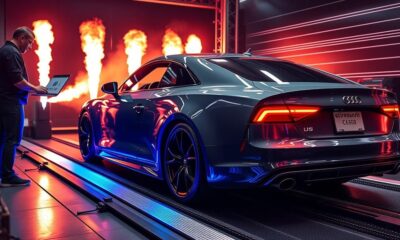
 Audi Tuning3 months ago
Audi Tuning3 months agoChip Tuning Audi: How to Unlock Extra Power Instantly
-
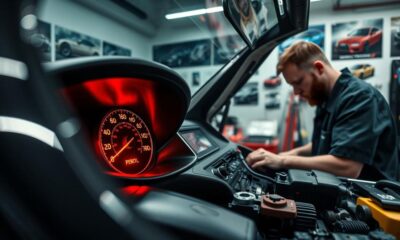
 Automotive DIY and Professional Guides3 months ago
Automotive DIY and Professional Guides3 months agoWhen Is Car Tuning Required? Signs It’s Time for an Upgrade
-
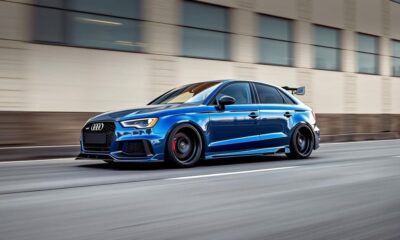
 Audi Tuning3 months ago
Audi Tuning3 months agoAudi A3 Tuning: Elevate Your Compact Car’s Performance
-
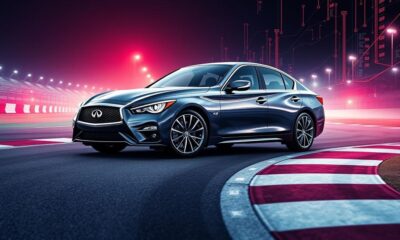
 Hybrid Tuning3 months ago
Hybrid Tuning3 months agoInfiniti Q50 Hybrid Chip Tuning: Enhance Performance With Precision Tuning
-

 Hybrid Tuning3 months ago
Hybrid Tuning3 months agoNissan Altima Hybrid Tuning: Upgrade Your Sedan for Maximum Efficiency
-

 Hybrid Tuning3 months ago
Hybrid Tuning3 months agoCube Reaction Hybrid Tuning: Get the Most Out of Your Electric Bike





